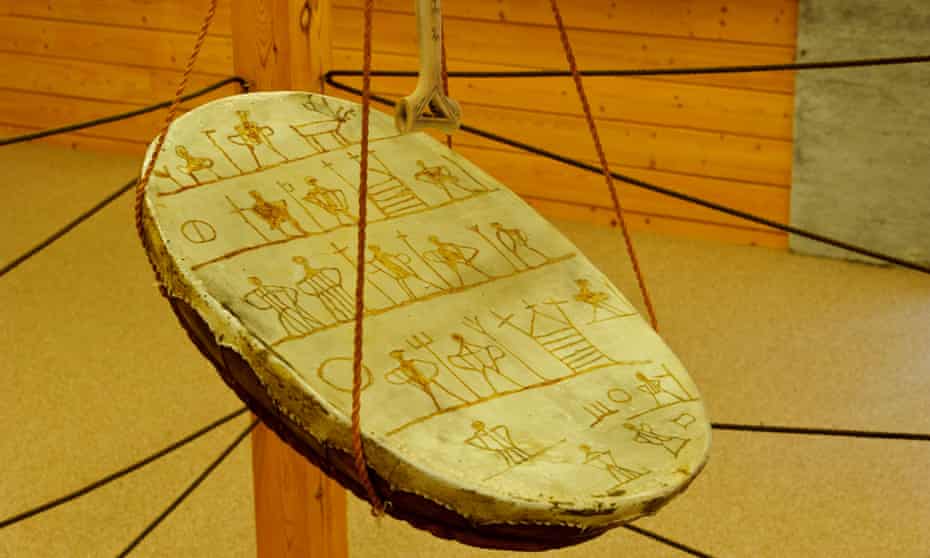As a venerated artefact returns to northern Norway, a people take ownership of their own history

‘The Sámi people have long been the victims of internal colonialism’:
rune drum in the museum at Karasjok, Norway.
Photograph: Interfoto/Alamy
Fri 15 Apr 2022
This week the Indigenous Sámi people of Norway celebrated a historic event: the return to the village of Karasjok (Kárášjohka in the northern Sámi language) of a rune drum that had been confiscated in 1691 from a Sámi man who was tried for witchcraft. At the time, the Nordic colonisers of the Arctic were energetically Christianising the Sámi population, whose animist spirituality depended on a sense of connectedness with the lands they inhabited and the animals with which they interacted. Rune drums, made from birchwood and reindeer skin, helped a noaidi, or shaman, to enter a trance and walk among spirits. They could also be used to divine future events: insight was gained by noting where, when the drum was struck, a ring moved in relation to the symbols painted on its surface.
This particular noaidi drum – there are many examples in museums in Sweden, Germany, the UK and elsewhere – happens to be particularly well documented. The court transcripts survive, including a detailed account given by its owner, Poala-Ánde, of its uses. He claimed, poignantly, that “he wanted to help people in distress, and with his art he wanted to do good”. A verdict was never reached in the trial since, before it could be handed down, Poala-Ánde was brutally murdered. The confiscated drum was sent to the authorities in Copenhagen and passed into the royal collection, becoming part of the National Museum of Denmark. Over the past 40 years, during which time the drum has been on loan to the Sámi Museum in Karasjok, the Sámi people have been arguing for ownership to be formally handed over to the institution. After an appeal to Queen Margrethe of Denmark, that has at last happened. “I feel,” said Silje Karine Muotka, president of the Sámi parliament in Norway, “that [Poala-Ánde’s] power is with us as we continue to take ownership of our own history for future generations.”
The Sámi people – whose population of 60-70,000 is scattered through Sweden, Norway, Finland and Russia’s Kola peninsula – have long been the victims of internal colonialism, their views sidelined in the rush for natural resources, whether timber, nickel or even wind power. Now they find themselves on the frontline of climate crisis, with rising temperatures affecting Arctic weather patterns, ecosystems, and traditional ways of living such as reindeer herding. But, with a revival in political self-consciousness, and a young generation taking back the dwindling Sámi languages and taking pride in their culture, the people of the Sápmi nation are taking their place among a network of Indigenous peoples from around the world, notably those from the Amazon, who are increasingly being recognised as holders of knowledge that may yet help the wider world tackle climate crisis. Later this month, too, Sámi artists will step on to the global stage when they exhibit in the Nordic pavilion – renamed this year the Sámi pavilion – at the world’s most celebrated international art event, the Venice Biennale. The Sámi drum is a powerful symbol of a people insisting on the validity of their belief systems – systems that tell us that humans, animals and land are intimately connected, and that harm to one means harm to all.
No comments:
Post a Comment